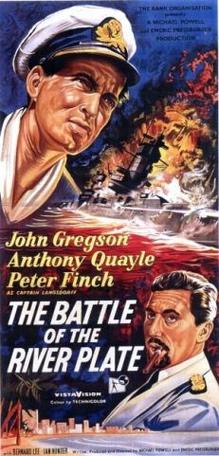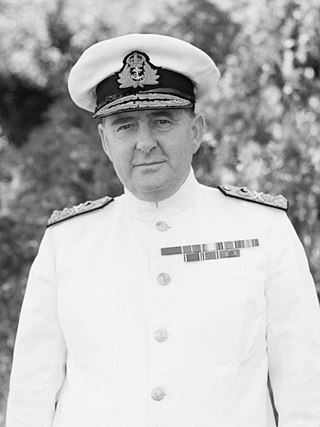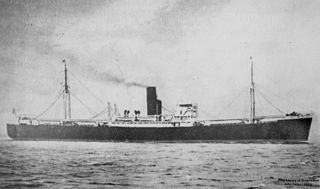
The Battle of the River Plate was fought in the South Atlantic on 13 December 1939 as the first naval battle of the Second World War. The Kriegsmarine heavy cruiser Admiral Graf Spee, commanded by Captain Hans Langsdorff, engaged a Royal Navy squadron, commanded by Commodore Henry Harwood, comprising the light cruisers HMS Ajax, HMS Achilles and the heavy cruiser HMS Exeter.

HMNZS Achilles was a Leander-class light cruiser, the second of five in the class. She served in the Royal New Zealand Navy in the Second World War. She was launched in 1931 for the Royal Navy, loaned to New Zealand in 1936 and transferred to the new Royal New Zealand Navy in 1941. She became famous for her part in the Battle of the River Plate, alongside HMS Ajax and HMS Exeter and notable for being the first Royal Navy cruiser to have fire control radar, with the installation of the New Zealand-made SS1 fire-control radar in June 1940.

The Battle of the River Plate is a 1956 British war film in Technicolor and VistaVision by the writer-director-producer team of Michael Powell and Emeric Pressburger. The film stars John Gregson, Anthony Quayle, Bernard Lee and Peter Finch. It was distributed worldwide by Rank Film Distributors Ltd.

Hans Wilhelm Langsdorff was a German naval officer, most famous for his command of the German pocket battleship Admiral Graf Spee before and during the Battle of the River Plate off the coast of Uruguay in 1939. After the Panzerschiff was unable to escape a pursuing squadron of Royal Navy ships, Langsdorff scuttled his ship. Three days later he died by suicide in his hotel room in Buenos Aires, Argentina.

Maximilian Johannes Maria Hubert Reichsgraf von Spee was a naval officer of the German Kaiserliche Marine, who commanded the East Asia Squadron during World War I. Spee entered the navy in 1878 and served in a variety of roles and locations, including on a colonial gunboat in German West Africa in the 1880s, the East Africa Squadron in the late 1890s, and as commander of several warships in the main German fleet in the early 1900s. During his time in Germany in the late 1880s and early 1890s, he married his wife, Margareta, and had three children, his sons Heinrich and Otto and his daughter Huberta. By 1912, he had returned to the East Asia Squadron as its commander, and was promoted to the rank of Vizeadmiral the following year.

The York class was the second and final class of heavy cruisers built for the Royal Navy under the terms of the 1922 Washington Naval Treaty. They were essentially a reduced version of the preceding County class, scaled down to enable more cruisers to be built from the limited defence budgets of the late 1920s.

HMS Ajax was a Leander-class light cruiser which served with the Royal Navy during World War II. She became famous for her part in the Battle of the River Plate, the Battle of Crete, the Battle of Malta and as a supply escort in the siege of Tobruk. This ship was the eighth in the Royal Navy to bear the name. In February 1942, she was adopted by the civil community of Halifax.

Admiral Sir Henry Harwood Harwood, KCB, OBE, was a British naval officer who won fame in the Battle of the River Plate.

HMS Cumberland was a County-class heavy cruiser of the Royal Navy that saw action during the Second World War.

The Deutschland class was a series of three Panzerschiffe, a form of heavily armed cruiser, built by the Reichsmarine officially in accordance with restrictions imposed by the Treaty of Versailles. The ships of the class, Deutschland, Admiral Scheer, and Admiral Graf Spee, were all stated to displace 10,000 long tons (10,160 t) in accordance with the Treaty, though they actually displaced 10,600 to 12,340 long tons at standard displacement. The design for the ships incorporated several radical innovations, including the first major use of welding in a warship and all-diesel propulsion. Due to their heavy armament of six 28 cm (11 in) guns and lighter weight, the British began referring to the vessels as "pocket battleships". The Deutschland-class ships were initially classified as Panzerschiffe, but the Kriegsmarine reclassified them as heavy cruisers in February 1940.

Club Hotel de la Ventana was a large, luxurious hotel resort, built by the Buenos Aires Great Southern Railway and opened in 1911 near Villa Ventana, 17 km from the town of Sierra de La Ventana, in the southeast of the Province of Buenos Aires, Argentina.

Germany–Uruguay relations are foreign relations between Germany and Uruguay. Germany has an embassy in Montevideo. Uruguay has an embassy in Berlin, a consulate-general in Hamburg and 6 honorary consulates. Germany is Uruguay's principal trading partner in the European Union.

Admiral Graf Spee was a Deutschland-class "Panzerschiff", nicknamed a "pocket battleship" by the British, which served with the Kriegsmarine of Nazi Germany during World War II. The vessel was named after World War I Admiral Maximilian von Spee, commander of the East Asia Squadron who fought the battles of Coronel and the Falkland Islands, where he was killed in action. She was laid down at the Reichsmarinewerft shipyard in Wilhelmshaven in October 1932 and completed by January 1936. The ship was nominally under the 10,000 long tons (10,160 t) limitation on warship size imposed by the Treaty of Versailles, though with a full load displacement of 16,020 long tons (16,280 t), she significantly exceeded it. Armed with six 28 cm (11 in) guns in two triple gun turrets, Admiral Graf Spee and her sisters were designed to outgun any cruiser fast enough to catch them. Their top speed of 28 knots left only a few capital ships in the Anglo-French navies fast enough and powerful enough to sink them.

Uruguay remained neutral for most of World War II. The policy of President Alfredo Baldomir, leading the Colorado Party, was to support the Allied cause, but from a neutral base. Great Britain retained considerable influence with the Baldomir regime, largely through the efforts of Sir Eugen Millington-Drake, who was the British Minister in Montevideo from 1934 to 1941. In January 1942, Baldomir terminated diplomatic relations with the Axis powers. He resigned in 1943 and his neutrality policy was continued by his successor Juan José de Amézaga, also of the Colorado Party. In February 1945, having signed the Declaration by United Nations, Amézaga declared war on Germany and Japan.

MV Carnarvon Castle was an ocean liner of the Union-Castle Line. She was requisitioned for service as an auxiliary cruiser by the Royal Navy during the Second World War.
The following events occurred in December 1939:

SS Clement was a British turbine steamship operated by the Alfred Booth and Company from 1934 to 1939 until she was intercepted and sunk by the German pocket battleship Admiral Graf Spee off the east coast of Brazil becoming the first victim of Graf Spee's commerce raiding sortie
SS Doric Star was a British cargo liner operated by the Blue Star Line from 1922 to 1939, when she was intercepted and sunk by the German pocket battleship Admiral Graf Spee off the coast of South West Africa, becoming the seventh victim of the commerce raiding sortie of Graf Spee.
MS Africa Shell, was a British coastal oil tanker operated by the Shell Company of East Africa Ltd. The ship's life was short, lasting only a matter of months from her introduction into service in 1939, until she was intercepted and sunk by the German pocket battleship Admiral Graf Spee in the Mozambique Channel, off the coast of Portuguese East Africa, becoming the sixth victim of Graf Spee's commerce raiding sortie.
SS Tairoa was a British cargo liner and refrigerated freight ship, operated by the Shaw, Savill & Albion Line from 1920 to 1939, until she was intercepted and sunk by the German pocket battleship, Admiral Graf Spee, off South West Africa, becoming the penultimate victim of Graf Spee's commerce raiding sortie.


















